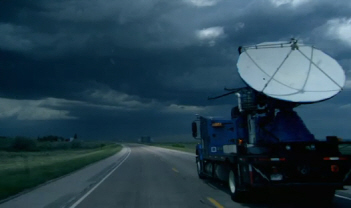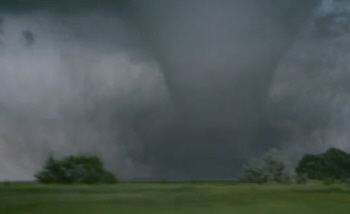Tornadoes, Storms, Floods & Haboobs
The Earth is a violent, dangerous planet
As our planet's orbit takes us towards June, it can still power great seasonal change. And this gives rise to some dramatic weather phenomena that are concentrated at this time of the year. The most extreme occurs over the Midwest of the United States. Every spring day we experience the interaction between the Earth's orbit and its tilt. At its most simple, the days get longer and the land gets warmer. But it also affects the atmosphere, with important consequences. It's the driving force behind the most significant weather events on our planet.

A Twister
A tornado is the most volatile of the seasonal weather events. They occur most frequently in the spring and especially in the Midwest of America, a region known as tornado alley. But despite its violence, at the core of the tornado is a very simple process.
To experience it, I'm taking to the air, over the Midwestern state of Colorado. Paragliding pilots like Honza Rejmanek, love this time of year. Spring provides the perfect conditions for soaring because the increasing temperatures generate thermals. Thermals form when the sun warms the ground, and the ground, in turn, warms the air above it. What I'm experiencing is one of the most fundamental principles of atmospheric physics, warmer air rises. When air warms, it expands and becomes less dense. So this air has a lower atmospheric pressure than the cooler air that surrounds it. So it floats upwards, forming this rising thermal column.
The atmosphere tries to even out differences in air temperature and pressure, attempting to return to equilibrium so the rising thermal will mix with the cooler air above. This basic process of moving towards equilibrium lies at the heart of every significant weather event on the planet.

Weather Radar
But in the springtime air over tornado alley there's a regional anomaly that intensifies this basic atmospheric process. The result is that here, particularly powerful storms can develop. There's a stable layer of dry air that acts as a barrier between the warm air known below and the cooler air higher up. So the warm air is trapped and what's more, the ground keeps heating it as a day goes on. The thermals get more and more powerful until, by late afternoon, they finally punch through the barrier layer at colossal speed. These rapid updraughts of less dense, lower pressure air are so strong that they generate huge thunderstorms. It's from these thunderstorms that, in certain conditions, tornadoes can emerge.
I'm going to investigate how this happens with the help of atmospheric scientist, Josh Wurman. The first step in our quest for the tornado is locating a promising storm. After a couple of days on the road, we managed to intercept one moving north through Colorado. So what's happening behind me is the storm's building and in the middle of that storm there is an updraught with low pressure at the centre of it. And all the air around the outside has higher pressure, and that high pressure is pushing air into the centre and up into the storm, and that's what's building the storm.

The Birth of a Tornado
The atmosphere tries to even out the extreme differences in temperature that have been generated. So the air movements at the core of the storm become exceptionally powerful. Hail is one characteristic product of this atmospheric violence. The hail formed when an updraught cooled rapidly, so that water condensed out of the air, and turned immediately to ice.
Even though this is chaotic and messy, what this is, is a demonstration that the atmosphere is an unstable place, and there are all these differences in temperature is and pressures. And this is what happens when atmosphere moves around to even everything out, and make it all the same. It's not looking very peaceful at the moment but that's what it's trying to get back to.
When tornadoes do form, they are often preceded by hail. But this time, there is no twister. So we are back on the road, still trying to see if storm spawn a tornado.
After a week of tracking promising storms without success, Josh's specialised radar detects one which shows is revealing swirl of clouds. We have to move fast, tornadoes form and vanish very quickly. Tornadoes form when powerful rotating cylinders of air within the storm get caught by an updraught and are knocked on the side. When that column of rotating air touches the ground, a tornado is born. At the tornado's core is an area of intense low-pressure, which draws high-pressure air towards it. The dust and debris picked up by the tornado reveal the swirling pattern of winds.
Just 15 minutes after it first touched down, the tornado dissipates. There is still so much that we don't understand about storms. We don't understand when they are going to produce hail, when they will produce rain, or when they'll produce tornadoes. But what we do understand is that a storm like this is just a manifestation of something happening around us all the time. Our planet's atmosphere is a mosaic of warmer and cooler air masses, constantly in motion. The air is rising, falling and swirling around as it seeks to balance out it's differences in temperature and pressure and return to equilibrium.

Dust Storm over Phoenix, Arizona
During April and May the effect of the Earth's tilt is to enhance those differences by increasing surface temperatures, which isn't an heat the air. So all over the northern hemisphere, spring is the season for volatile storms. Tornadoes are only one consequence. The heavy and the sudden downpours from storms can result in flash floods like the one that hit the town of Barranquilla in Colombia in May 2011. These occur when the rain inundate is densely saturated ground. The water isn't fully absorbed, but instead was rapidly downhill in a near instantaneous torrent.
Thunderstorms can also give birth to an unexpected phenomenon, massive dust storms called haboobs. This one blew into to Phoenix, Arizona in 2011. Haboobs are produced in normally arid regions when the leading edge of the storm collapses, generating a super-fast downdraught that kicks up a wall of dust and sand in front of it.
As May turns to June, the volatility in our atmosphere drives the biggest single weather event on the planet. An event centred on the Indian subcontinent. - The Monsoon.




